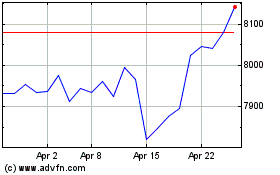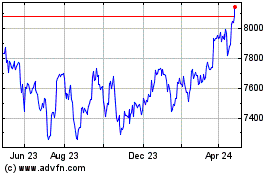By Barbara Kollmeyer, MarketWatch , Suryatapa Bhattacharya and
Ryan Vlastelica
Investors also looking ahead to start of Fed meeting
The U.S. dollar strengthened on Tuesday as the British pound
fell to its lowest level since January against the buck, a day
after U.K. lawmakers set the stage for Brexit talks to begin.
However, market direction could shift in the coming day
following the Federal Open Market Committee's two-day meeting,
which is scheduled to get under way later Tuesday and is widely
expected to result in an interest rate hike.
Against the dollar, the pound dropped to $1.2130 from $1.2219
late Monday in New York, a move of about 0.7%. The pound hasn't
been that weak against the dollar since Jan. 17, when it fell to an
intraday low of $1.204, according to FactSet Research. With the
day's move, the pound is down 2% for the month of March, and 1.8%
thus far in 2017.
The U.K. parliament passed the Brexit bill on Monday
(http://www.marketwatch.com/story/uk-house-of-commons-reject-amendments-clearing-brexit-obstacle-2017-03-13)
(http://www.marketwatch.com/story/uk-house-of-commons-reject-amendments-clearing-brexit-obstacle-2017-03-13),
giving Prime Minister Theresa May the ability to begin the formal
process of the country's exit from the European Union. She is
expected to make a move to begin the two years of negotiations
before the end of March.
Read:A EUR60 billion bill and other hurdles for the U.K. in the
face of Brexit
(http://www.marketwatch.com/story/a-60-billion-bill-and-other-hurdles-for-the-uk-in-the-face-of-brexit-2017-03-13)
But May's triumph was ambushed by Scotland's First Minister
Nicola Sturgeon. On Monday, the Scottish leader said she plans to
seek approval to hold a second referendum on Scottish independence
(http://www.marketwatch.com/story/scottish-first-minister-nicola-sturgeon-confirms-plans-for-independence-vote-2017-03-13)
before Brexit happens. The move compounded any concerns the market
has regarding Brexit.
"This complicates the task facing the UK government as they have
won parliamentary authority to trigger Article 50," said Mihir
Kapadia, CEO and Founder of Sun Global Investments. "The lower
pound is proving to be good for UK exports but inflation which is
already showing signs of a significant revival could be boosted
further."
Versus the yen, the pound dropped 0.6% to Yen139.58. Against the
euro , the pound dropped 0.6% to EUR1.1395.
Thursday's Bank of England meeting and monetary policy
announcement were also a talking point for investors.
Koji Fukaya, chief executive of FPG Securities, said if the Bank
of England is seen to be dovish, the pound could weaken against the
euro. If the U.K.'s central bank was seen remaining neutral, it
could drive further euro strength against the pound in the short
term. In short, the currency pair was "very hot," Fukaya said.
Investors are also keeping an eye on Dutch election, to be held
Wednesday, which they believe could gauge the risk of a eurozone
breakup. The shared currency was supported by the European Central
Bank's indication last week that it might not take fresh easing
steps, despite caution over the election in the Netherlands.
Read: Who is the 'Dutch Trump' Geert Wilders, and why should
investors care?
(http://www.marketwatch.com/story/who-is-the-dutch-trump-geert-wilders-and-should-investors-be-worried-about-him-2017-03-10)
"The Dutch election will be one indicator of how the trend in
Brexit and (U.S. President Donald) Trump's victory translates to
continental Europe," said Shusuke Yamada, FX strategist with Bank
of America Merrill Lynch in Tokyo.
Fed ahead
Despite an overnight rise in the U.S. Treasurys rate, the
dollar's reaction remained muted to expectations of a rate hike on
Wednesday because investors have already priced it in
(http://www.marketwatch.com/story/fed-may-not-pull-any-punches-in-policy-statement-2017-03-13),
said analysts.
Read: One chart shows how remarkably relaxed investors are about
rising interest rates
(http://www.marketwatch.com/story/one-chart-shows-how-remarkably-relaxed-investors-are-about-rising-interest-rates-2017-03-13)
The ICE U.S. Dollar Index , which measures the currency against
a basket of six major rivals, was up 0.3% to 101.61, largely due to
strength against the pound. The WSJ Dollar index, which looks at
the buck against a wider set of currencies, rose 0.2% to 91.89.
The euro traded at $1.0632 from $1.0653, a move of about 0.2%.
Against the yen , the dollar traded at Yen114.86 from
Yen114.88.
Investors are awaiting a Bank of Japan meeting later this week,
in addition to any Fed news.
"To reignite the movement in foreign-exchange market, we want to
see probably more than just a March hike," said BAML's Yamada.
A shift in the Fed's so-called dot plot this year or in
long-term equilibrium interest rate -- meaning if the U.S. central
bank indicates four instead of three interest rate increases --
would surprise markets and in that case the dollar-yen pair could
be seen breaking above the Yen115-range, which would mean that
"Yen115 might become a floor rather than a ceiling," said Yamada.
The dot plot is a forecast of the Fed members' projections for
future interest rates, which was most recently implying three rate
increases for 2017.
-- Kenan Machado and Hiroyuki Kachi contributed to this
article.
(END) Dow Jones Newswires
March 14, 2017 08:35 ET (12:35 GMT)
Copyright (c) 2017 Dow Jones & Company, Inc.
FTSE 100
Index Chart
From Mar 2024 to Apr 2024

FTSE 100
Index Chart
From Apr 2023 to Apr 2024
